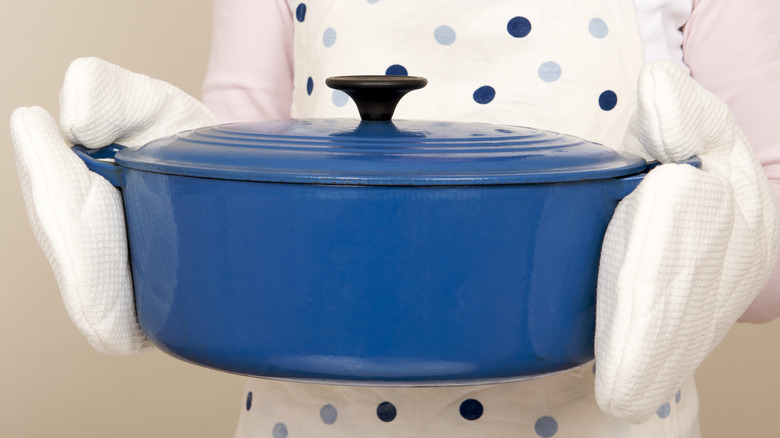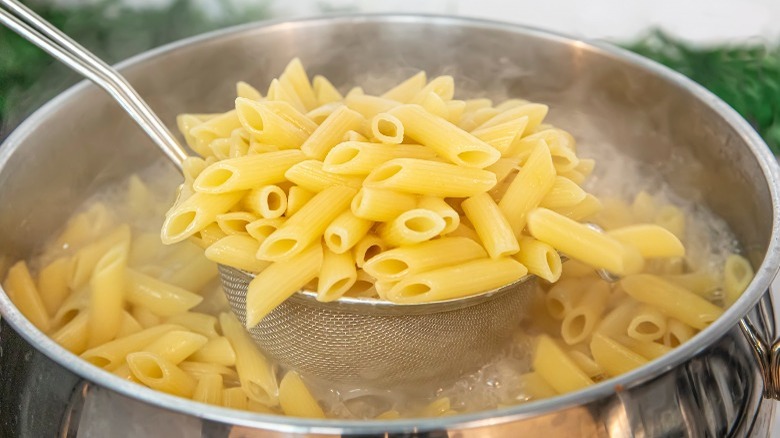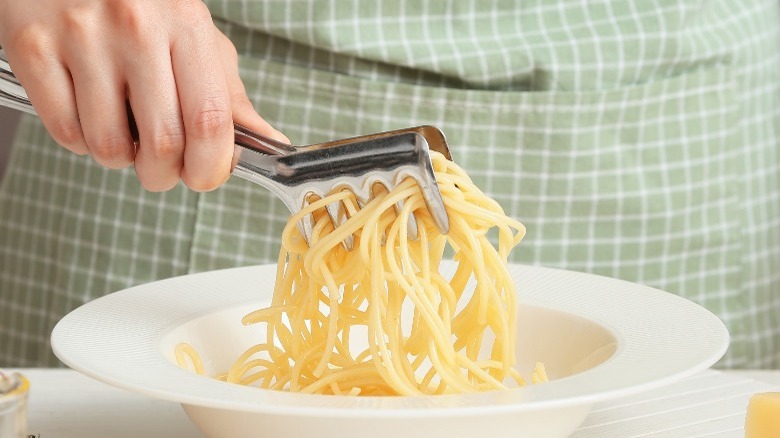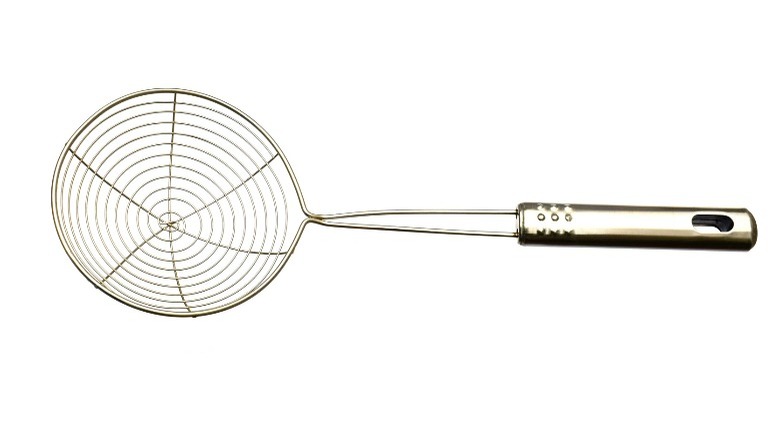How To Strain Pasta When You Don't Have A Colander
If you're a fan of pasta, you might wonder why we'd need a list like this. You're probably thinking, "Who doesn't have a colander?" Yet, there are many reasons someone might not have a colander on hand. Issues like space constraints or a sadly unequipped vacation rental, or perhaps someone follows the keto diet and really only has pasta once or twice a year, so buying a colander just feels like an epic waste of money and space. Whatever the reason you've found yourself facing down a pan of boiling water and freshly cooked pasta without a colander, never fear — you've come to the right place.
Though colanders do make draining your favorite pasta quick and easy, there are a variety of simple ways to drain that pot of starchy water and rescue your pasta before it turns to mush. (Besides, the internet showed us back in 2020 that some of y'all don't know how to use a colander properly anyway, so you might as well try one of these adaptations and see if you prefer it.)
With all of this in mind, here are a few handy hacks to help you muddle your way through the next time you find yourself craving pasta with nary a colander in sight.
Handheld mesh strainer or chinois
Just hear us out — a strainer is NOT a colander. Technically, they both drain water from pasta easily, but there are significant differences between the two, per Fine Dining Lovers, beginning with size. As far as space savings go, a handled small or medium-sized fine-mesh strainer fits perfectly into almost any cupboard, or better yet, hangs directly on your kitchen wall. Not only that, but it's ideal for the ol' dip and pour: Dip the strainer into your pot of freshly cooked pasta (cooked al dente, please) allowing it to drain slightly before pouring it directly into your bubbling sauce to finish, waiting patiently on the next burner.
A chinois could be a bit of a stretch, as it might stand to reason that if you don't own a colander, odds are you probably don't have a chinois — but you never know! Maybe your grandma or great aunt Hildy sent one over in that box of stuff they don't need anymore. (You should go check. It's that conical metal thing you used as a witch's hat as a kid.) Seriously though, the Chicago Tribune describes the mesh chinois as "one of the greatest inventions of culinary tools." It's usually reserved to ensure silken sauces and gravies are lump-free, but, hey, if you've got one lying around, you could use it to strain pasta. Chef Nick Tamburo prefers it to a colander, telling Eater, "You can use a chinois for everything you would use a colander for, plus so much more. Its selling point is its versatility."
Spoons
Spoons, glorious spoons, in all sorts of incarnations: large serving spoons, skimming spoons, slotted spoons, and pasta spoons (the ones with a hole in the center that look like they have little spikes sticking up on the edges). All of these spoons come in the big, hearty varieties used for cooking and serving, and can be found made of materials like metal, rubber, and silicone (via Nigella). Great for dishing up things like potato salad or a heaping plate of fettuccine, basically everyone has one or more of these kinds of spoons hanging around their kitchen. And that means you have the perfect utensil already on hand for snatching al dente pasta from its watery bath.
The slotted and spaghetti-serving styles work best, as they allow boiling water to drain right out, but even if you only have a big solid nylon or metal spoon, your pasta can make its exit gracefully, albeit painstakingly.
Lids
If all else fails, you've got the lid your pan came with, don't you? Believe it or not, that's all you really need to strain pasta. In fact, senior product analyst in the Kitchen Appliances & Technology Lab at Good Housekeeping Betty Gold notes that many saucepans these days come with a strainer already built into their lids, which means no need for that pesky colander at all.
But what if your pan lid is kicking it old school and is missing those requisite peepholes? No problem, says Bon Appétit, suggesting taking safety precautions when using your pan lid to drain pasta water. "Leave the lid slightly askew, about ¼ inch. Hold the lid down with insulated oven mitts. Make sure to hold the pot away from you as you pour — otherwise you risk steam burns," the article points out. This method allows you to drain the water out while letting the lid catch any pasta that would otherwise find itself in your sink. A word of caution though: Don't choose this option if you're unwilling to take extra care, you'll be risking the possibility of a steam or boiling water burn.
Tongs
When it comes to draining pasta, some people swear by a good set of tongs. In fact, when it comes to long pasta types — such as spaghetti, linguini, fettuccine, pappardelle, and the like — tongs are often the go-to noodle retriever of chefs everywhere. While any tong will do when liberating long noodles from a big pot of water, if you wanna ensure maximum pasta-pulling efficiency, look for specially designed pasta tongs. Just like the pasta serving spoons, these little babies have stubby, finger-like tips sticking up along the edges of the tongs' powerful pinchers, allowing your noodles to drape gracefully without slipping free of their grasp.
Epicurious recommends this pasta exclusive tool, noting that, "By having tines on the tongs, it's easy to pick up and swirl stringy foods without them slipping out." While British celebrity chef Gordon Ramsay still uses his colander to drain pasta, as you can see from his video on "How to Cook The Perfect Pasta," he uses his tongs throughout the pasta cooking process to keep noodles loose and free, and to test when it has reached its desired level of doneness.
Spider
James Briscione of the Institute of Culinary Education in New York City shared his preferred method of draining pasta with Today, noting that the best way to drain pasta is to "scoop it directly from the water into your sauce — you want to get a little of that starchy water into your sauce to improve the flavor and texture of the sauce and also help the sauce hold on to the pasta better." In a YouTube video, Briscione can be seen using what looks like a spider for this — which is exactly the tool celebrity chef, author, and restaurateur Lidia Bastianich swears by for straining pasta.
Spider strainers, also known as skimmers, are traditionally used in Asian cooking, as well as for frying. These long-handled, spiral metal or woven wire nets vaguely resemble a spider web, and have become a favorite tool of chefs like Bastianich, who told Today, "Boy does that do wonders to pull pasta out of the water!" Bon Appétit calls the tool "extremely useful," explaining that it's not only great for straining pasta, but also for removing dumplings, eggs, and blanched veggies from boiling water.
Turns out, with more than one way to nab your noodles for a nosh from the pot, colanders may even get left behind. With more than enough reasonable alternatives for replacement, you may want to consider ditching that space-hogging colander in favor of one of these delightful pasta-draining hacks and pursue pasta perfection.





